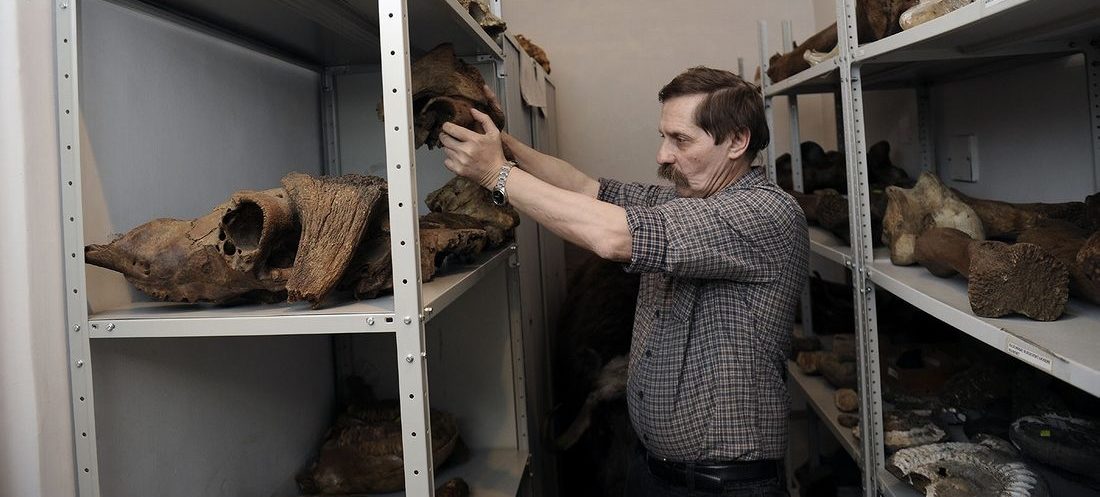A native Muscovite, after graduating from Moscow State University, he came to Norilsk to get acquainted with the life of Taimyr and the animals he studied at the Vertebrates Zoology Department.
Vladimir Larin spent more than ten years on the Putorana plateau, studying the Taimyr snow sheep and the musk ox. In 1984, thanks to the active participation of Vladimir Larin, the republican reserve Putoransky was formed in the central part of the plateau. Seven years later, the founder became its director.
Larin’s perseverance and determination helped to achieve the most important event for the entire Taimyr territory – the Putorana plateau was recognized as a UNESCO World Heritage Site.
The scientist devoted the last few years of his life to the Norilsk Museum.
“Vladimir took me under his wing. He explained every detail concerning animals and plants, interpreted scientific terminology in simple words, even drew pictures – a sort of manual for dummies, – said a guide and researcher Ekaterina Kaverina. “I could listen to him for three or four hours in a row and did not mind the time. It was so interesting”.
Many city dwellers remember what love and care Vladimir Larin felt about a musk ox Grishka by name. It lived in the Putoransky reserve, and Norilsk residents were fond of this pet. People often brought Vladimir wounded chicks, animals found in the vicinity, and each time he helped, or gave a piece of advice.
“He had a clear understanding of natural processes: if a wounded bird does not survive, the Arctic fox will survive thanks to her. Vladimir reckoned with the nature laws and always said that it was better to let wounded animals enter the natural environment”, recalls Ekaterina.
Larin was buried in Moscow. Ekaterina Kaverina was among those who accompanied him on his last journey. After meeting the scientist’s family, she realized why he was that kind of person.
“Vladimir’s mother is also from a scientist. A very strong, wise woman with a great sense of humor. She joked that she preferred botany, and her son went “along the spines”. After all, first time he got acquainted with biology was at the age of six months in the Moscow zoo. And it became fateful.
There are legends about Larin’s sense of humor. In the journalistic milieu, if you come to him for a comment meant you would lose half a day, and it was very informative, easy, and really imperceptible. People could not help listening to him. A lot of different stories from life on the Putorana plateau, stories about animals and people who were nearby during the expeditions. All this saturated communication with him with incredible colors”, says Ekaterina.Vladimir knew how to recognize people. If someone hooked him in a good or negative sense, the person received a nickname. Surprisingly capacious and memorable. So, Vasilisas, Rhino, Leader, Queen, Mouse, Flame Motor and others appeared in the museum. I was nicknamed a Snow Girl. Such subtle characteristics, phrases, quotes of classics, always attracted people and represented the man as an educated, well-read, but at the same time easy-to-communicate person. If you needed advice, we all asked Larin for it. He always gave it in an unusual way: not a call to action, but something to think of. He sorted out your situation, examined it from all sides, and the solution became obvious.
His reasoning, his stories and views on life were engraved in our memory. And although two years have passed already, I still remember every word. He had both an administrative skill and a scientist’s grip. He would have been an amazing teacher and professor if he had wanted to”.
Humanity and love for animals, incredible love for Taimyr “without pink glasses” – this is what Vladimir Vladimirovich’s colleagues characterize today. Norilsk became his life, and he himself became an important component of Norilsk history. Always remembered.
Read in The territory genius: why Valeria Bolgova is called a queen of the tundra.
Text: Julia Gubeladze, Photo: Nikolay Shchipko and Vladimir Larin’s personal archive










